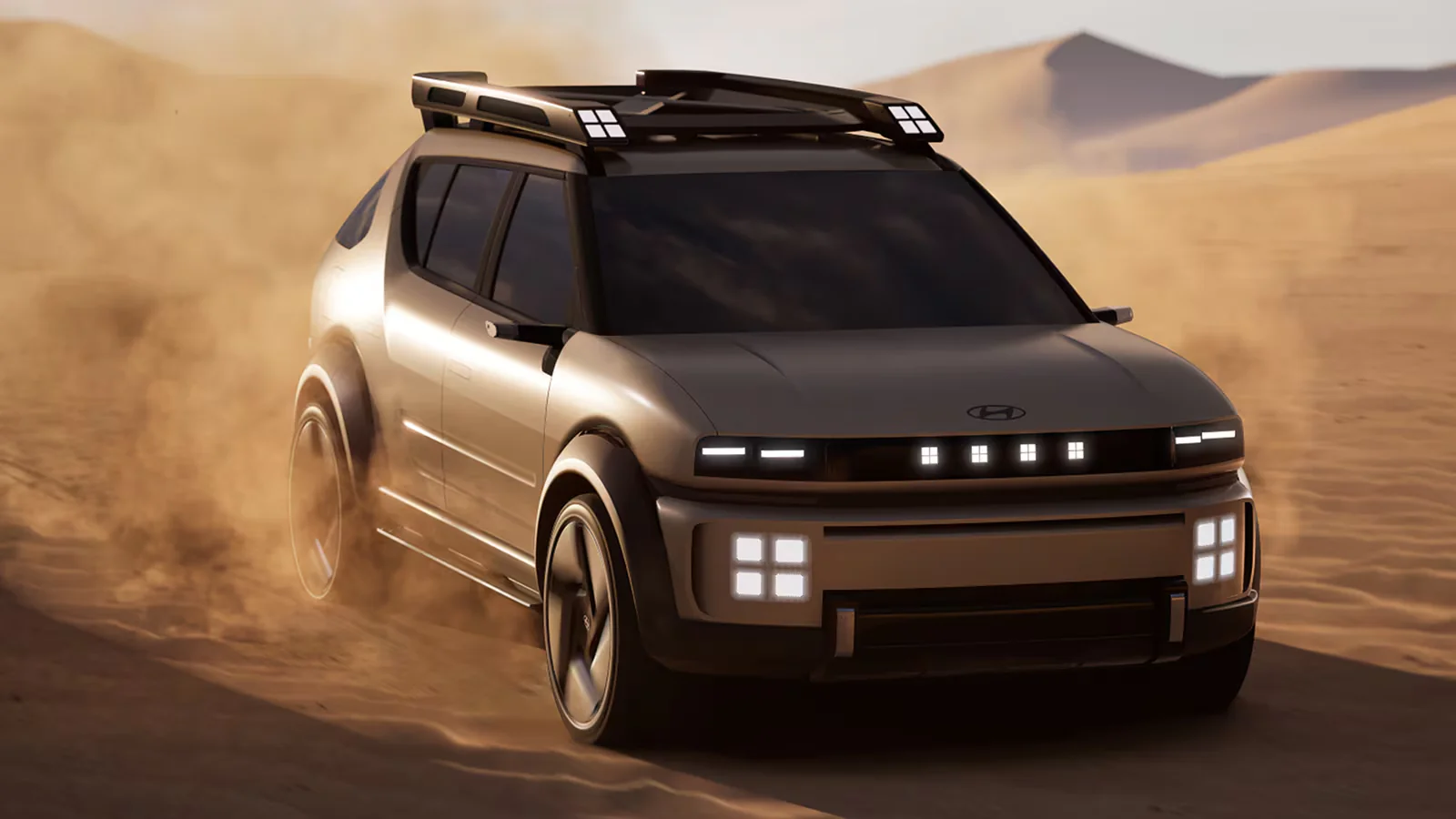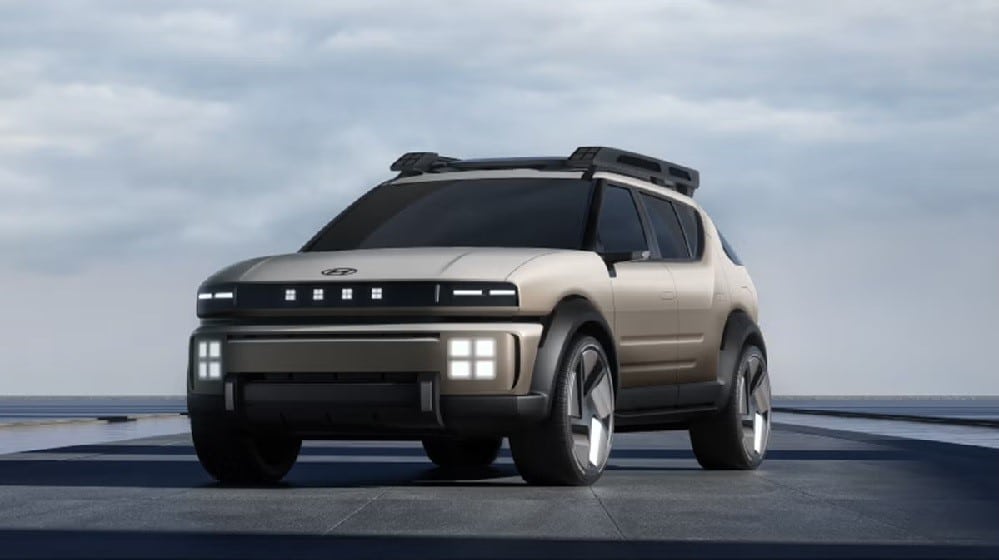Hyundai’s newest hydrogen vehicle is ready for its moment in the spotlight—though some details remain elusive.
Named Initium, the Latin term for “beginning” or “first,” this SUV concept provides a glimpse into Hyundai’s upcoming passenger fuel-cell model, set to debut in production form in the first half of 2025.
(Quick, someone check in with the Toyota Prius about how it feels regarding this naming choice.)
Interestingly, the Latin plural of Initium translates to “mysteries,” an apt descriptor for the technical details of the Fuel Cell Electric Vehicle (FCEV) that Hyundai has yet to unveil.
However, the company has shared a few key details. The Initium will feature large hydrogen fuel tanks—though their exact size remains undisclosed—and low-rolling-resistance tires designed to optimize range.
Hyundai is aiming for a driving range exceeding 400 miles, supported by a maximum motor output of 150 kW. The Initium is set to improve on the performance of Hyundai’s current FCEV, the Nexo.
It boasts an improved zero-to-100-km/h acceleration time of 8.0 seconds, compared to the Nexo’s 8.4 seconds (as tested by Car and Driver).
Highway passing speeds from 80 to 120 kph are reported to take 6.0 seconds. Jin Hwan Jung, Hyundai’s senior vice president overseeing vehicle development technology, described this as “outstanding acceleration performance compared to competitor FCEVs” during a presentation in Seoul.
The new production model will incorporate Hyundai’s third-generation fuel cell stack.
This innovation builds on the first-generation stack introduced with the 2013 Tucson FCEV, which offered a power density of 2.09 kW/l, and the second-generation stack in the 2018 Nexo, which increased to 3.2 kW/l.
While Hyundai has not disclosed specific power density figures for the latest stack, engineers confirmed that it represents a significant improvement, with a 40% boost in durability compared to the Nexo’s stack.
A notable feature of the Initium is its vehicle-to-load (V2L) capability. A small door on the rear passenger side reveals a 220-volt household outlet, standard in Korea, allowing the Initium to supply power externally.
Fully fueled, the Initium can generate approximately 100.0 kWh of offboard power—enough to sustain a typical Korean household for around 10 days, according to Hyundai.
Hyundai has emphasized the Initium’s aesthetic appeal, introducing a new design philosophy dubbed “Art of Steel.” This concept highlights a rugged exterior intended to suit both urban and outdoor environments.
The SUV features blocky fenders combined with golden steel accents, offering a robust evolution of the Nexo’s design.
Though Hyundai has not revealed the interior, it did confirm the presence of nine airbags, driver monitoring via an in-cabin camera, and safety features like Highway Drive Assist.

SangYup Lee, Hyundai’s global design chief, described the Initium as a “flagship” for the future hydrogen society.
Through an interpreter, he explained, “We took a new approach of exposing the materiality as it is, and we elevated the resilience of steel to morphological beauty.
We call it the ‘Art of Steel,’ and this is the starting point of essential beauty you can feel from this car.”
Design details include Hyundai’s signature parametric pixel lighting elements, visible in the square headlamps, grille, and integrated roof rack.
The HTWO symbol—resembling two connected “H” letters—appears in the roof rack and rear mirrors.
Lee noted, “With the armored design bumper invoking a solid hydrogen tank and rear steel parts exposed instead of a muffler, we made the car look strong and rugged.”
Despite its bold, angular aesthetic, the Initium incorporates softer design elements to avoid looking excessively blocky.
Curves in the 21-inch wheels, the C-pillar, and the rear window lend the vehicle a refined balance.
Horizontal stripes connect the front wheels to the rear doors, suggesting a cohesive design well-suited for production.
However, Hyundai clarified that the Initium’s primary role is to embody the character of HTWO, Hyundai Motor Group’s hydrogen-focused brand.
The vehicle’s unveiling served not only to highlight its features but also to provide insight into Hyundai’s vision for a hydrogen-powered future.
Hyundai Motor President and CEO Jaehoon (Jay) Chang stated through an interpreter, “We will build the hydrogen ecosystem for cleaner, quieter, and safer fuel cell EVs to effortlessly become part of your daily life, for everyone, everything, everywhere.”
While South Korea has better hydrogen refueling infrastructure than the U.S., owning an H2 vehicle there still presents challenges.
As of September 2024, the country has around 200 hydrogen refueling stations.
To address potential range anxiety, the Initium includes a specialized FCEV navigation system that not only guides drivers to hydrogen stations but also checks their operational status and current queues.
The Initium represents Hyundai’s ambitious step toward mainstreaming hydrogen-powered mobility, showcasing a blend of innovative technology, forward-thinking design, and practical functionality.

